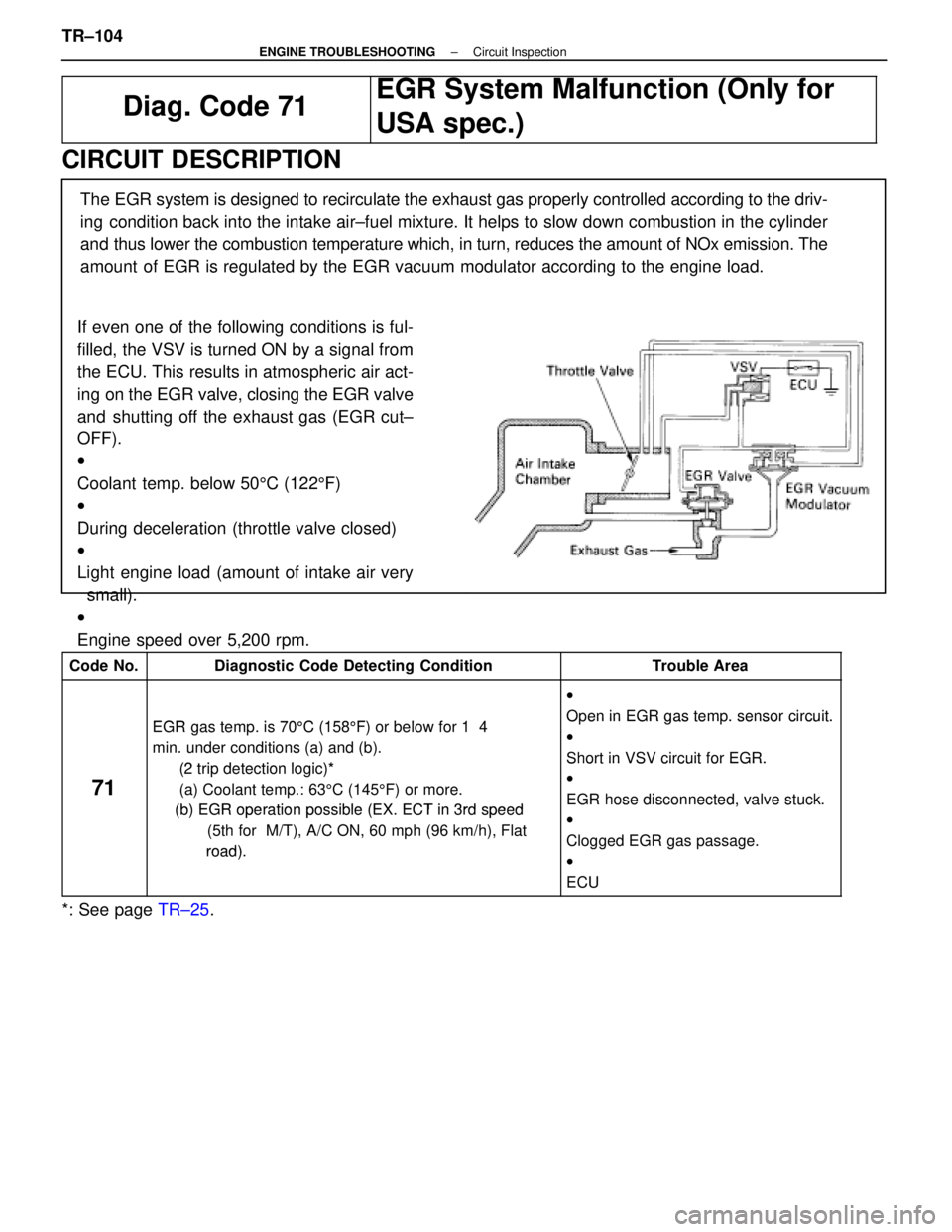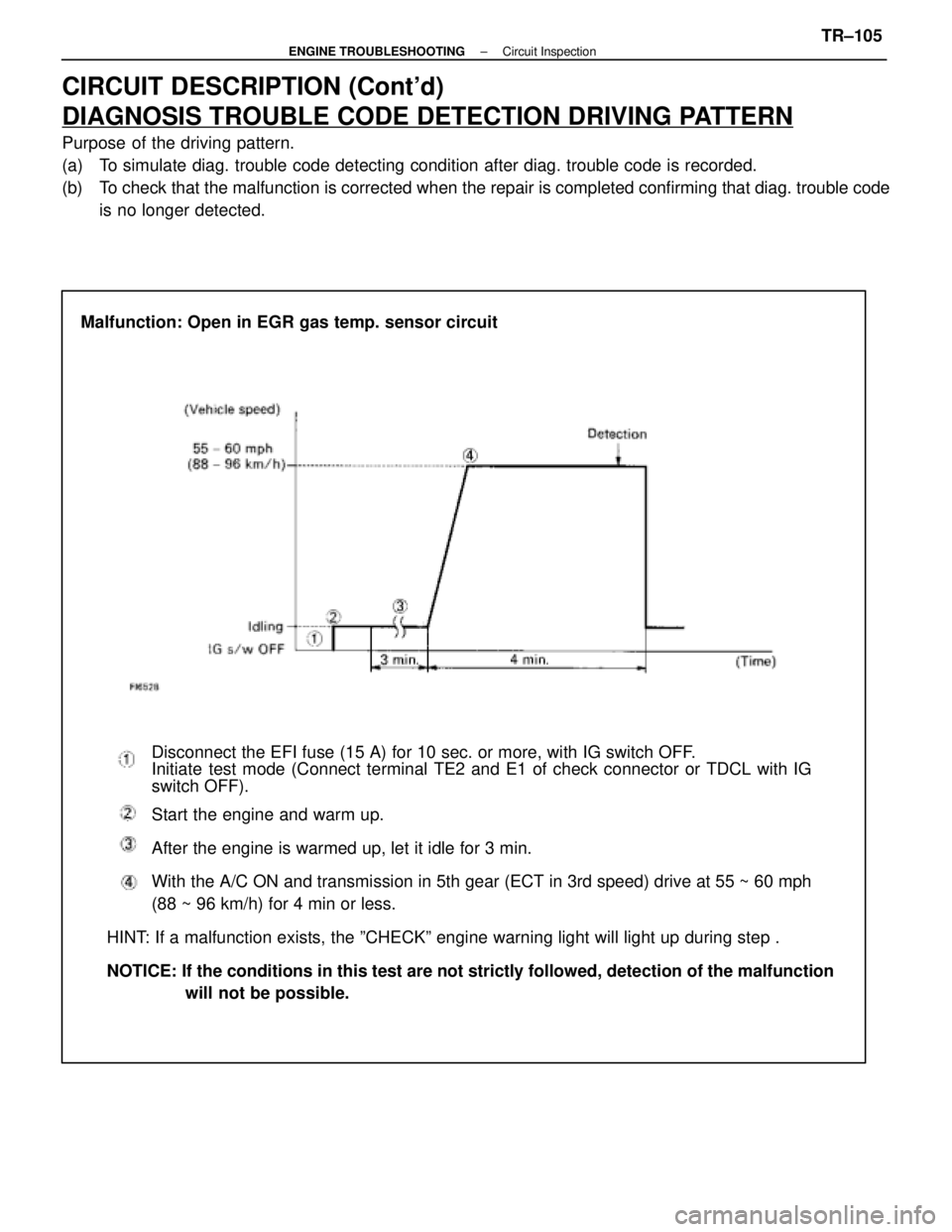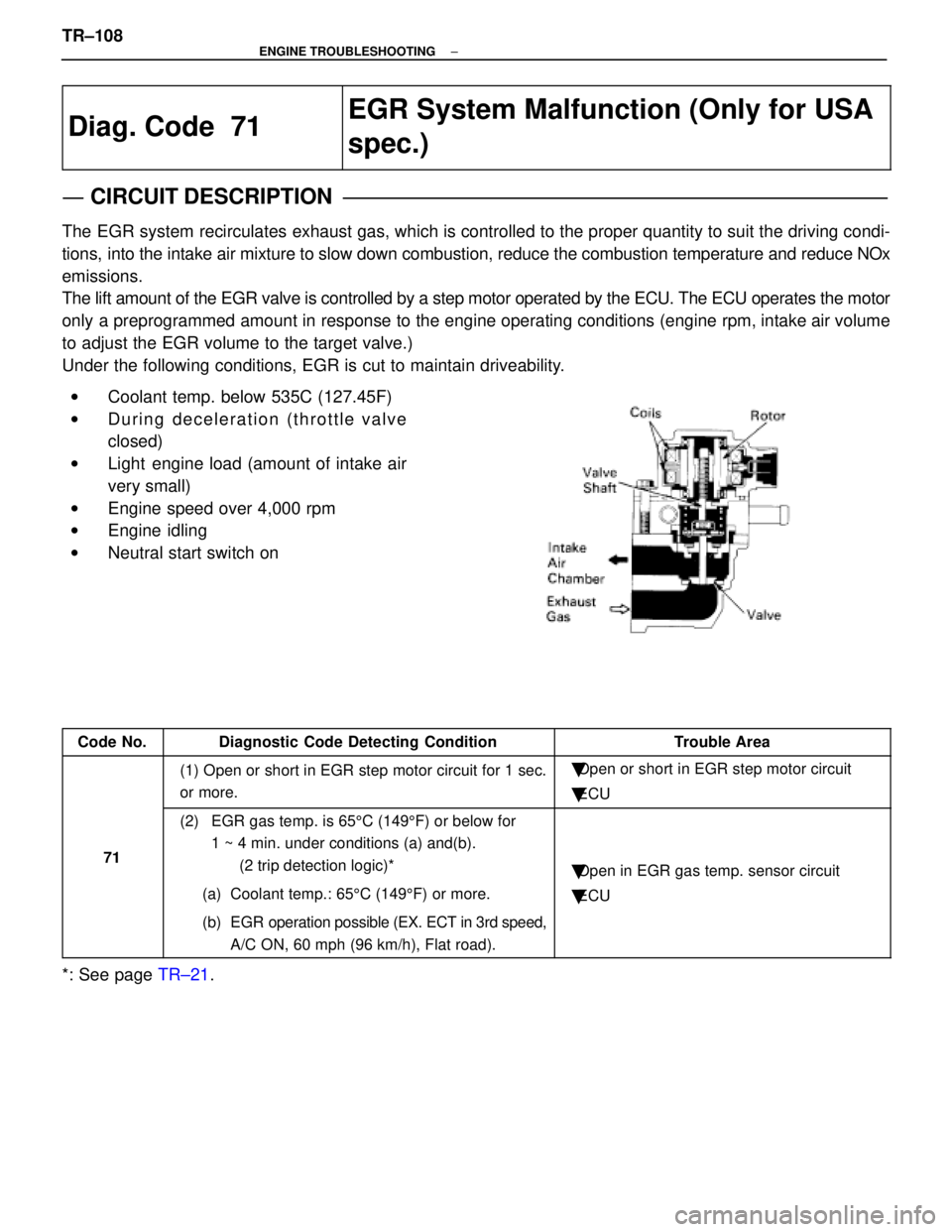Page 3733 of 4087
NGOK
OKNG
INSPECTION PROCEDURE
1Check continuity between terminals KNK1, KNK2 of engine & ECT ECU connector and body
ground.
C
OK
P(2) Connect the Check Harness A.(See page TR±30)
(2) Disconnect the engine & ECT ECU connector.
Measure resistance between terminals KNK1, KNK2 of
engine & ECT ECU connector and body ground.
Resistance: 1 M � or higher
Go to step 3.
2Check knock sensor.
C
OK
PDisconnect knock sensor connector.
Measure resistance between the knock sensor terminal
and body.
Resistance: 1 M � or higher
Replace knock sensor (See page FI±108).
±
ENGINE TROUBLESHOOTING Circuit InspectionTR±105
WhereEverybodyKnowsYourName
Page 3734 of 4087
OKNG
NOYES
3
Check for open and short in harness and connectors between engine & ECT ECU a\
nd knock
sensor (See page IN±27)
Repair or replace harness or connector.
4Does malfunction disappear when a good knock sensor is installed?
Replace knock sensor (See page FI±108).
Check and replace engine & ECT ECU.
Reference | INSPECTION USING OSCILLOSCOPE
w With the engine racing (4,000 rpm) measure
between terminals KNK1, KNK2 of engine & ECT
ECU and body ground.
HINT: The correct waveform appears as shown in the Illustration on the left.
w Spread the time on the horizontal axis, and confirm
that period of the wave is 151 sec.
(Normal mode vibration frequency of knock sensor:
6.6 KHz).
HINT: If normal mode vibration frequency is not 6.6 KHz, the sensor is malfunctioning.
TR±106
±
ENGINE TROUBLESHOOTING Circuit Inspection
WhereEverybodyKnowsYourName
Page 3736 of 4087

Diag. Code 71
EGR System Malfunction (Only for
USA spec.)
CIRCUIT DESCRIPTION
If even one of the following conditions is ful-
filled, the VSV is turned ON by a signal from
the ECU. This results in atmospheric air act-
ing on the EGR valve, closing the EGR valve
and shutting off the exhaust gas (EGR cut±
OFF).
w
Coolant temp. below 505C (122 5F)
w
During deceleration (throttle valve closed)
w
Light engine load (amount of intake air very
small).
w
Engine speed over 5,200 rpm. The EGR system is designed to recirculate the exhaust gas properly controll\
ed according to the driv-
ing condition back into the intake air±fuel mixture. It helps to slow dow\
n combustion in the cylinder
and thus lower the combustion temperature which, in turn, reduces the amoun\
t of NOx emission. The
amount of EGR is regulated by the EGR vacuum modulator according to the engine\
load.
Code No.Diagnostic Code Detecting ConditionTrouble Area
EGR t i 70
5C (158 5F) b l f 1 4
w
Open in EGR
gas temp. sensor circuit.EGR gas temp. is 70 5C (158 5F) or below for 1 4
min. under conditions (a) and (b).
(2 trip detection logic)*
Oen in EGR gas tem. sensor circuit.
w
Short in VSV circuit for EGR.
71
(2 trip detection logic)*
(a) Coolant temp.: 63 5C (145 5F) or more.
(b) EGR operationpossible (EX ECT in 3rd speed
Short in VSV circuit for EGR.
w
EGR hose disconnected, valve stuck.
(b) EGR operation possible (EX. ECT in 3rd speed
(5th for M/T), A/C ON, 60 mph (96 km/h), Flat
road)
EGR hose disconnected, valve stuck.
w
Clogged EGR gas passage.
road).gg g g
w
ECU
*: See page TR±25.
TR±104
±
ENGINE TROUBLESHOOTING Circuit Inspection
WhereEverybodyKnowsYourName
Page 3737 of 4087

CIRCUIT DESCRIPTION (Cont'd)
DIAGNOSIS TROUBLE CODE DETECTION DRIVING PATTERN
Purpose of the driving pattern.
(a) To simulate diag. trouble code detecting condition after diag. trouble co\
de is recorded.
(b) To check that the malfunction is corrected when the repair is completed co\
nfirming that diag. trouble codeis no longer detected.
Malfunction: Open in EGR gas temp. sensor circuit
Disconnect the EFI fuse (15 A) for 10 sec. or more, with IG switch OFF\
.
Initiate test mode (Connect terminal TE2 and E1 of check connector or TDCL with\
IG
switch OFF).
Start the engine and warm up.
After the engine is warmed up, let it idle for 3 min.
With the A/C ON and transmission in 5th gear (ECT in 3rd speed) drive at 5\
5 ~ 60 mph
(88 ~ 96 km/h) for 4 min or less.
HINT: If a malfunction exists, the ºCHECKº engine warning light will l\
ight up during step .
NOTICE: If the conditions in this test are not strictly followed, detection of \
the malfunction will not be possible.
±
ENGINE TROUBLESHOOTING Circuit InspectionTR±105
WhereEverybodyKnowsYourName
Page 3738 of 4087
DIAGNOSTIC CHART
Check voltage of VSV for EGR Power
source.
Check resistance of VSV for EGR.
Repair or replace harness or
connector.
Replace VSV for EGR.
Check for open and short in harness and
connector between EFI main relay and ECU.
Check and replace EGR.
Check EGR system (See page EC±12).
Check resistance of EGR gas temp. sensor.
Check and replace EGR.
Check for open in harness and connector
between EGR gas temp, sensor and ECU.
Repair EGR system.
Replace EGR gas temp. sensor.
Repair or replace harness or
connector.
TR±106±
ENGINE TROUBLESHOOTING Circuit Inspection
WhereEverybodyKnowsYourName
Page 3741 of 4087
OKNG
OKNG
OKNG
4Check EGR system (See page EC±12).
Repair EGR system.
5Check resistance of EGR gas temp. sensor.
C
OK
PRemove EGR gas temp. sensor.
Measure resistance between terminals of EGR gas
temp. sensor connector.
Resistance: 69 ± 89 k � at 50 �C (122 �F)
12 ± 15 k � at 100 �C (212 �F)
2 ± 4 k � at 150 �C (302 �F)
Replace EGR gas temp. sensor.
6Check for open in harness and connector between EGR gas temp. sensor and engi\
ne (& ECT)
ECU. (See page IN±27).
Repair or replace harness or connector.
Check and replace engine (& ECT) ECU.
±
ENGINE TROUBLESHOOTING Circuit InspectionTR±109
WhereEverybodyKnowsYourName
Page 3742 of 4087

Diag. Code 71
EGR System Malfunction (Only for USA
spec.)
CIRCUIT DESCRIPTION
The EGR system recirculates exhaust gas, which is controlled to the proper quantity to suit the driv\
ing condi-
tions, into the intake air mixture to slow down combustion, reduce the combust\
ion temperature and reduce NOx
emissions.
The lift amount of the EGR valve is controlled by a step motor operated \
by the ECU. The ECU operates the motor
only a preprogrammed amount in response to the engine operating conditions (\
engine rpm, intake air volume
to adjust the EGR volume to the target valve.)
Under the following conditions, EGR is cut to maintain driveability.
wCoolant temp. below 535C (127.45F)
w During deceleration (throttle valve
closed)
w Light engine load (amount of intake air
very small)
w Engine speed over 4,000 rpm
w Engine idling
w Neutral start switch on
Code No.Diagnostic Code Detecting ConditionTrouble Area
(1) Open or short in EGR step motor circuit for 1 sec.
or more.�Open or short in EGR step motor circuit
� ECU
71
(2) EGR gas temp. is 65 5C (149 5F) or below for
1 ~ 4 min. under conditions (a) and(b).
(2 trip detection logic)*
(a) Coolant temp.: 65 5C (149 5F) or more.
(b) EGR operation possible (EX. ECT in 3rd speed, A/C ON, 60 mph (96 km/h), Flat road).
�Open in EGR gas temp. sensor circuit
� ECU
*: See page TR±21.
TR±108
±
ENGINE TROUBLESHOOTING
WhereEverybodyKnowsYourName
Page 3743 of 4087
CIRCUIT DESCRIPTION (Cont'd)
DIAGNOSIS CODE DETECTION DRIVING PATTERN
Purpose of the driving pattern.
(a) To simulate diag. code detecting condition after diag. code is recorded.
(b) To check that the malfunction is corrected when the repair is completed c\
onfirming that diag. code is nolonger detected.
�Initiate test mode (See page TR±12).
�Start engine and warm up.
�After engine is warmed up, let it idle for 3 min.
�With the A/C ON and transmission in D range (O/D OFF), drive at 40±\
70 mph for 4 min.
HINT: If a malfunction exists, the ºCHECKº engine warning light will light up at 1±4 min. of driving at 40±70 mph (64±112 km/h).
NOTICE: If the conditions in this test are not strictly followed, detection of the\
malfunction will not be possible.
Malfunction: Open in EGR gas temp. sensor circuit
±
ENGINE TROUBLESHOOTING Circuit InspectionTR±109
WhereEverybodyKnowsYourName